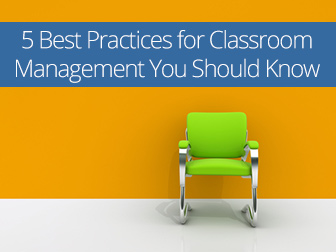Who's in Charge Here? 5 Best Practices for Classroom Management You Should Know


One memorable first day of the semester after winter break, when going over the syllabus, a beautiful young woman asked me why there was a rule about attendance. I explained that absences caused a loss of instruction. She looked at me with wide blue eyes and asked, “What’s instruction?” And I realized we indeed had our work cut out for us.
Such questions--“What’s instruction?” “Where’s the paper, again?” or “Do I really need to do the homework?”--are common in the first weeks of schools or after long breaks. Rather than despair, however, there are active steps instructors can take to get students oriented, or reoriented, to class while maintaining their own sanity. These steps address the problems students have to getting back into the flow, which tend to fall in several main ideas.
Most of student confusion over class tends not to be over actual course content but class rules and procedures—for when to talk in class, how to leave class for whatever reason, what to do when arriving late, and so on. All of these procedures and rules seem to consume the most time and cause the most confusion yet are necessary for the smooth running of a class.
Where are the handouts kept? The extra paper? Does the teacher have a stapler? Materials, where they are kept in class, and if students should bring their own, also seem to cause a lot of anxiety in students and take up a lot of time
The course content, what students are supposed to be learning, is of course why we are there and the most important element of class—but also what seems to get shoved aside at times as we deal with rules, procedures, and materials. In addition, this area can also cause confusion in students, obviously, who have been away from the class for awhile and may not quite know anymore where we are in the book.
So there is a lot of room for confusion in arriving in for the first time or returning to class, but there is help. On those days when students are wandering around the classroom saying things like “Where are the books, again?” and “When is break?” and “What page are we on?” don’t despair. There are several steps a teacher can take to orient her confused students.

If something is important enough to be a rule, it’s important enough to put in writing. Otherwise, it tends to remain ephemeral, a bit of smoke easily forgotten. Consider creating a list of your 10 most important class procedures, from what to do when you are late to how to contact the teacher, and posting it in class, or put it on the syllabus, post it or on your website, or perhaps all three.
You probably have heard the journalistic saying, “Tell them what you’re going to tell them. Tell them. Then tell them that you told them.” While this might seem overkill, it does emphasize the value of repetition in learning. People probably don’t internalize rules until they’ve heard them several times, so repeat or refer to the procedures several times in the first days of class.
Consider letting students have extended discussion on the rules—which ones they don’t understand or find necessary, which ones they believe make sense, which ones could probably be thrown out, and which ones to add. Often students have a good internal sense of appropriate behavior, even if they don’t practice it. Discussion also helps them better internalize the rules.
If paper and other supplies are in specific cabinets you would like students to know about, it might make sense to label it, so you aren’t repeating several times a class session where the books are but can just point. This also holds true for the activities of the day: if you write on the board what you will be doing, every time a student asks, “What page are we on again?” you can just point.
When students come in late, pause your lecture just long enough to say, “Michael, the handouts are on the table up here. Please get them and take your seat.” This models the behavior you want when students enter late and that there is a specific place where the day’s materials are kept.
Journals can be a valuable way to review content material students may be having trouble grasping: one or two pages summarizing the material itself, questions, comments and reaction, and new vocabulary can not only help students process the material, but also give you a good understanding of what students understand and what they are struggling with. Those areas can be addressed then in lecture and discussion.
When students know they are going to be tested on something, they are more likely to learn it, so after a week or two consider giving a short quiz on the rules and procedures as well as on content. This should not be a “pop” quiz but a quiz with at least a day for review scheduled.
After students have been away from class for spring break, for example, consider some refresher work as necessary on the classroom expectations, either through discussion, lecture, or a quiz. The same can be done for classroom content, with a review of the current chapter.
However, teachers stand a better stance of solidifying their students’ understanding of procedures and content through lecture, discussion, practice, and refreshers.